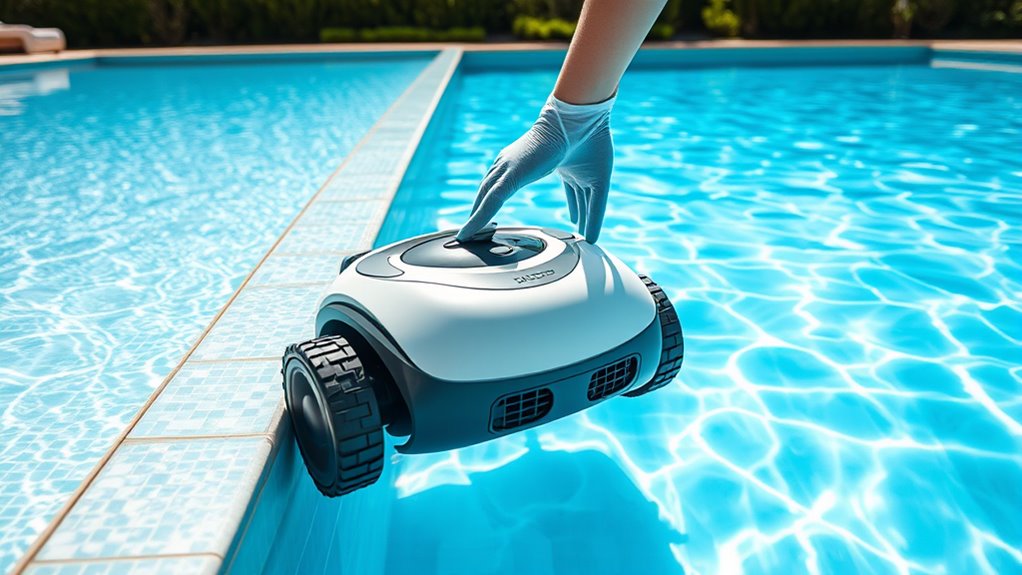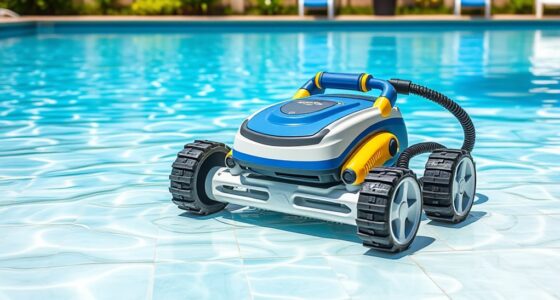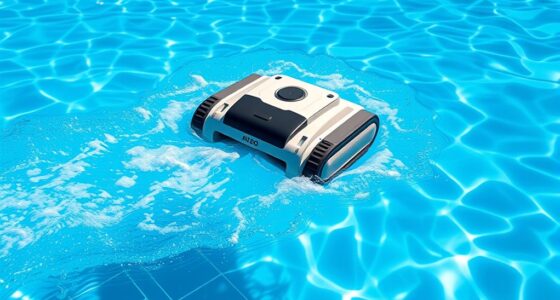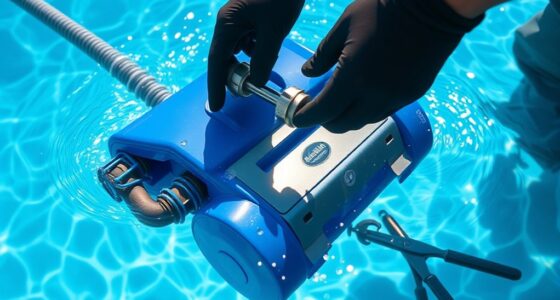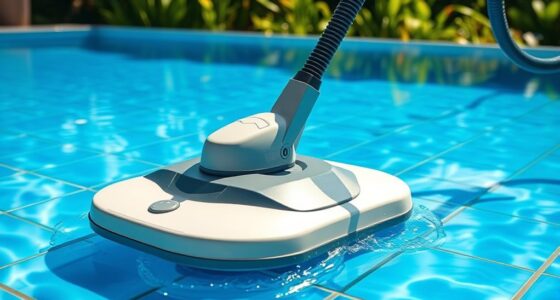To keep your robotic pool cleaner working well, check for signs like poor suction, sluggish response, or battery issues regularly. Clean filters, baskets, brushes, and scrubbing pads weekly, replacing worn parts as needed. Inspect the power cord and connections for damage, and store the device properly during the off-season after thorough cleaning. Following these steps and maintenance tips guarantees longevity—if you continue exploring, you’ll discover how to keep your cleaner in top shape year-round.
Key Takeaways
- Regularly inspect and clean filters, brushes, and baskets weekly to prevent clogs and maintain cleaning efficiency.
- Check battery health and firmware updates monthly; replace batteries or update software as needed.
- Examine power cords and connectors for damage, cracks, or corrosion during routine checks.
- Store the cleaner in a dry, cool place after fully charging and cleaning it at the end of each season.
- Increase maintenance frequency during peak debris periods and promptly replace worn parts to prolong lifespan.
Recognizing Signs That Indicate Your Cleaner Needs Servicing
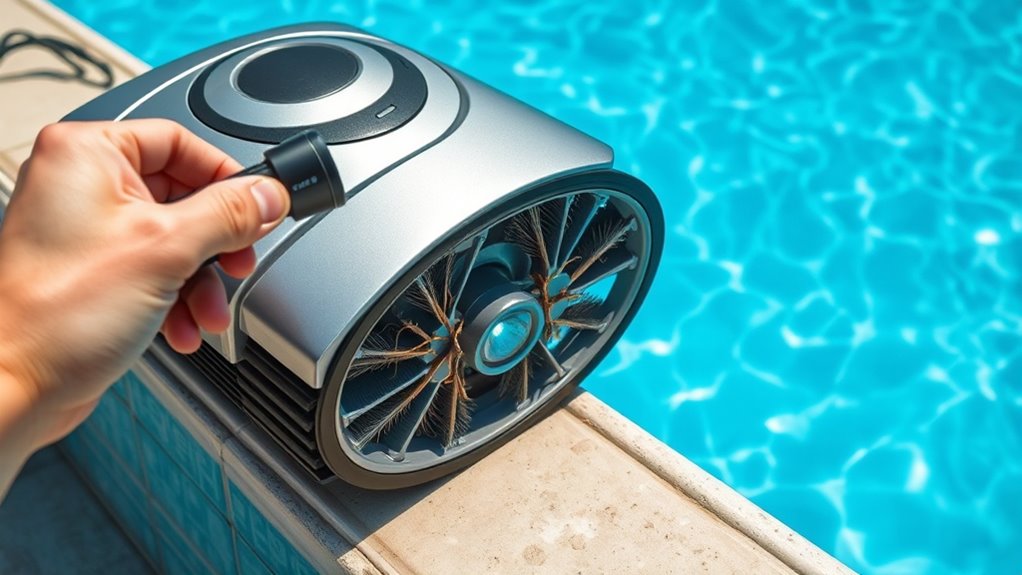
If your robotic pool cleaner isn’t performing as well as it used to, it’s a sign it might need servicing. One key indicator is declining battery health; if the cleaner doesn’t hold a charge or runs out quickly, it’s time to check the battery or consider replacing it. Additionally, software updates play an essential role—if your device isn’t responding properly or seems sluggish, ensuring it has the latest firmware can improve performance. Outdated software may cause glitches or limit functionality. Pay attention to these signs, as neglecting them can lead to further issues. Regularly monitor battery performance and stay current with software updates to keep your robotic pool cleaner operating efficiently, extending its lifespan and maintaining peak cleaning results. Incorporating AI advancements into device management could also help optimize maintenance schedules and detect issues proactively, ensuring better overall device performance. Moreover, understanding the importance of regular maintenance can prevent unexpected breakdowns and ensure consistent operation over time, similar to how tuning enhances vehicle performance and longevity.
Regular Inspection and Cleaning of the Device

Maintaining your robotic pool cleaner’s performance relies on regular inspection and cleaning. You should routinely check for debris, clean filters, and guarantee the device is free of obstructions. Battery maintenance is key—make sure to charge it fully and store it properly to extend its lifespan. Software updates are also vital; keep your cleaner’s firmware current to improve efficiency and fix bugs. Use the following table as a quick reference:
| Task | Details |
|---|---|
| Inspect for debris | Remove leaves, dirt, and obstructions |
| Clean filters | Rinse filters to maintain suction and cleaning power |
| Check battery status | Guarantee it charges fully and holds charge correctly |
| Update software | Download latest firmware from the manufacturer |
| Examine device exterior | Remove buildup and wipe down for peak operation |
| Regularly review product manuals | To stay informed about maintenance requirements |
Regular inspection keeps your cleaner running smoothly. Additionally, proper storage practices can significantly prolong the life of your device, especially if you follow manufacturer recommendations for seasonal storage. Ensuring all components are stored in a dry, cool place can prevent damage caused by environmental factors.
Checking and Replacing Brushes and Scrubbing Pads
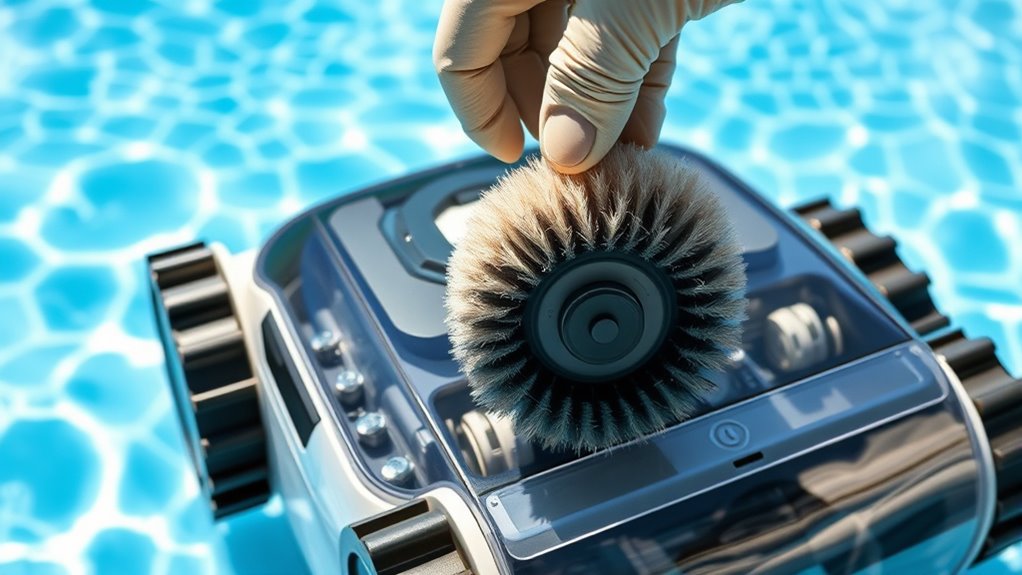
Over time, brushes and scrubbing pads can show signs of wear or damage. Knowing how to spot these issues and replace the parts correctly keeps your cleaner working efficiently. Here’s what to look for and tips to make the process straightforward. Regular inspection can also help prevent damage caused by skin irritation, which may occur if worn-out parts are used for extended periods. Additionally, understanding the cost-effectiveness of maintenance can help you decide when repairs are more economical than replacing the entire cleaner. It’s also beneficial to consult professional maintenance tips to ensure you’re following best practices for upkeep and longevity of your robotic pool cleaner.
Signs of Wear and Tear
Regularly inspecting the brushes and scrubbing pads on your robotic pool cleaner is essential to guarantee it performs at its best. Pay attention to signs of wear, like frayed bristles or smooth, worn surfaces, which reduce cleaning efficiency. Diminished battery life can also indicate that brushes or pads aren’t functioning properly, causing the unit to work harder and drain faster. Keep your software updated; outdated software can lead to inconsistent cleaning patterns and misdiagnosed wear issues. If you notice decreased suction, uneven cleaning, or the brushes aren’t spinning properly, it’s time to check for signs of wear and tear. Addressing these issues early ensures your cleaner maintains excellent performance and prolongs its lifespan. HEPA filters and UV-C light technology can also help ensure your pool remains free of airborne pollutants and odors, supporting overall pool environment quality. Regular maintenance of wear components and ensuring the proper functioning of all parts helps prevent costly repairs and keeps your robotic cleaner operating efficiently. Additionally, staying informed about AI in education and automation advancements can inspire innovative approaches to pool maintenance and management.
Replacement Procedures and Tips
To guarantee your robotic pool cleaner works effectively, checking and replacing the brushes and scrubbing pads when they show signs of wear is essential. Worn brushes can reduce cleaning efficiency and strain the motor, impacting overall battery health. Regularly inspect and replace these parts to maintain peak performance. Also, ensure your device’s software is up-to-date, as updates often improve cleaning algorithms and functionality. When replacing brushes or pads:
- Power off and unplug your cleaner before starting
- Remove worn brushes or pads carefully, following manufacturer instructions
- Clean any debris from the brush housing
- Reinstall new components securely, then run a software update if available
- Monitoring relationship patterns can help identify recurring issues that may affect your device’s performance over time. Additionally, paying attention to wear indicators can help you determine the optimal time for replacements before performance declines. Regular maintenance, including checking bulb wear, can also help prevent unexpected failures and extend the lifespan of your robotic pool cleaner. Performing routine inspections and maintenance is crucial to avoid damage caused by overuse, which can accelerate wear. For optimal results, consult your manufacturer’s guide on operating hours to avoid overuse that may accelerate wear.
Cleaning and Replacing the Filter and Mesh Baskets
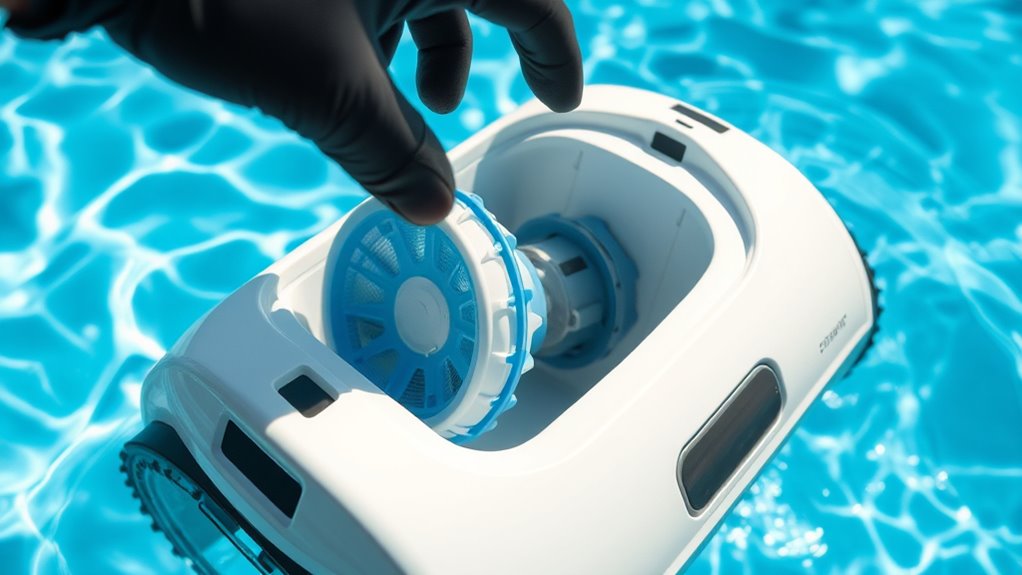
Cleaning and replacing the filter and mesh baskets is essential for keeping your robotic pool cleaner operating efficiently. Regular filter replacement ensures debris doesn’t clog the system, maintaining maximum suction and cleaning performance. To start, remove the mesh basket from your cleaner and rinse it thoroughly with a hose to remove dirt and debris. Use a soft brush if necessary to clear stubborn particles. Check the filter for wear or damage, replacing it if it’s torn or overly dirty. Mesh basket maintenance also involves inspecting for cracks or breaks that might compromise its function. Doing this weekly prevents clogs and ensures smooth operation. Proper care of the filter and mesh baskets extends your cleaner’s lifespan and keeps your pool sparkling clean. Additionally, using proper tuning techniques can help optimize your pool cleaner’s performance and longevity.
Inspecting and Maintaining the Power Cord and Connectors
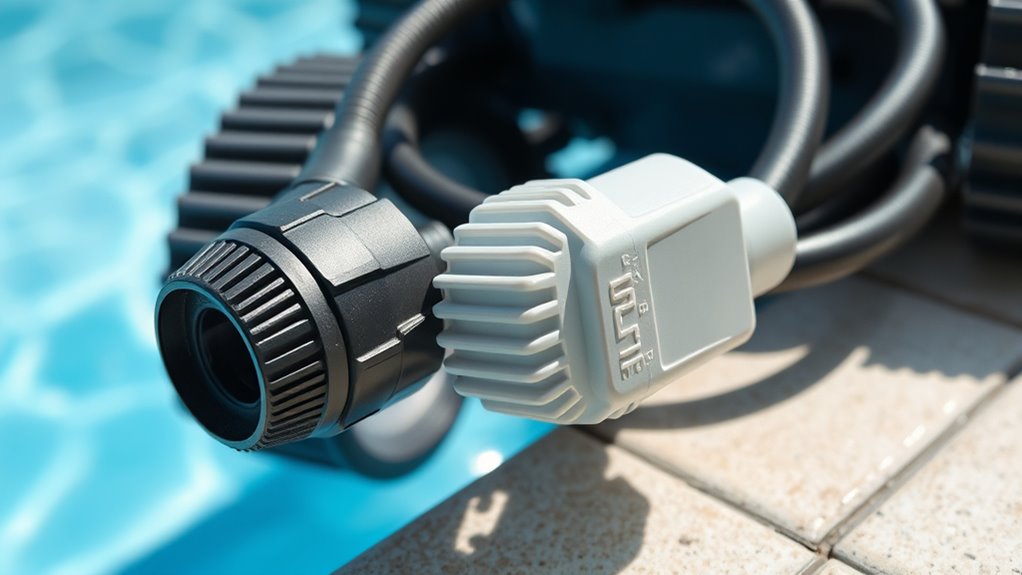
Since the power cord and connectors are essential for your robotic pool cleaner’s operation, it’s important to inspect them regularly for any signs of damage or wear. Regular power cord inspection helps prevent malfunctions and electrical hazards. Check for cuts, cracks, or exposed wiring that could compromise safety. Connector maintenance involves ensuring all connections are secure, free of corrosion, and not loose. Damaged connectors can cause intermittent operation or complete failure. To keep everything in top shape, look out for the following:
- Frayed or worn areas on the power cord
- Loose or corroded connectors
- Signs of water intrusion or rust
- Any deformation or bending in the cord or connectors
Addressing these issues promptly guarantees reliable operation and prolongs your cleaner’s lifespan.
Scheduling Routine Maintenance Based on Usage and Seasons
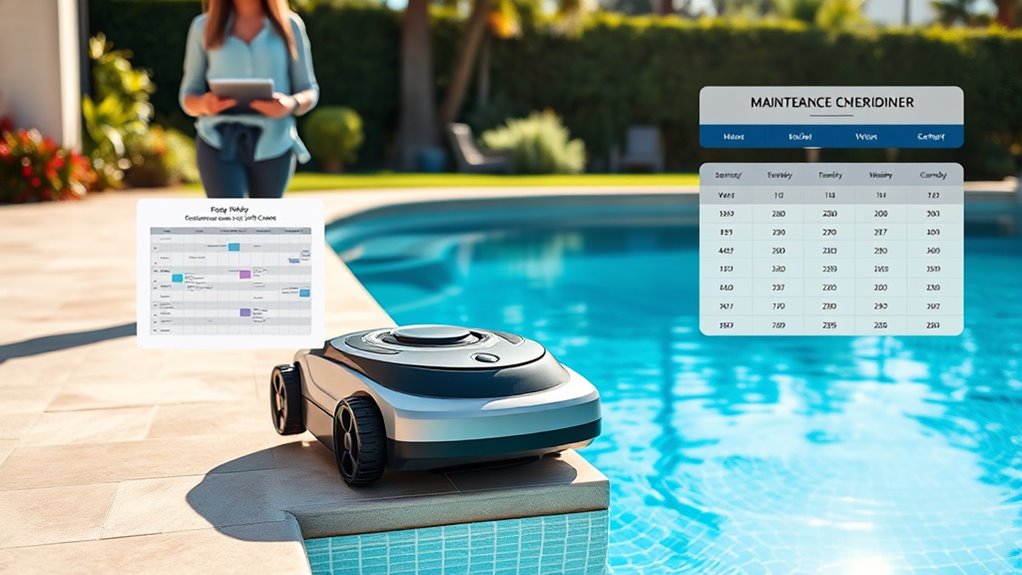
Adjusting your maintenance schedule according to how often you use your robotic pool cleaner and the changing seasons guarantees peak performance and longevity. During peak swimming months, you may need to clean and inspect your robotic cleaner models more frequently, especially if your pool chemistry fluctuates or debris increases. In colder months, reduce maintenance but still check for any build-up or wear. Monitoring your pool chemistry is essential to prevent algae and mineral deposits that can affect your cleaner’s operation. Regularly inspect brushes, filters, and casings, especially after heavy use or seasonal shifts. By tailoring your routine to your usage patterns and seasonal changes, you guarantee your robotic cleaner runs efficiently year-round, extending its lifespan and maintaining ideal pool cleanliness.
Troubleshooting Common Performance Issues
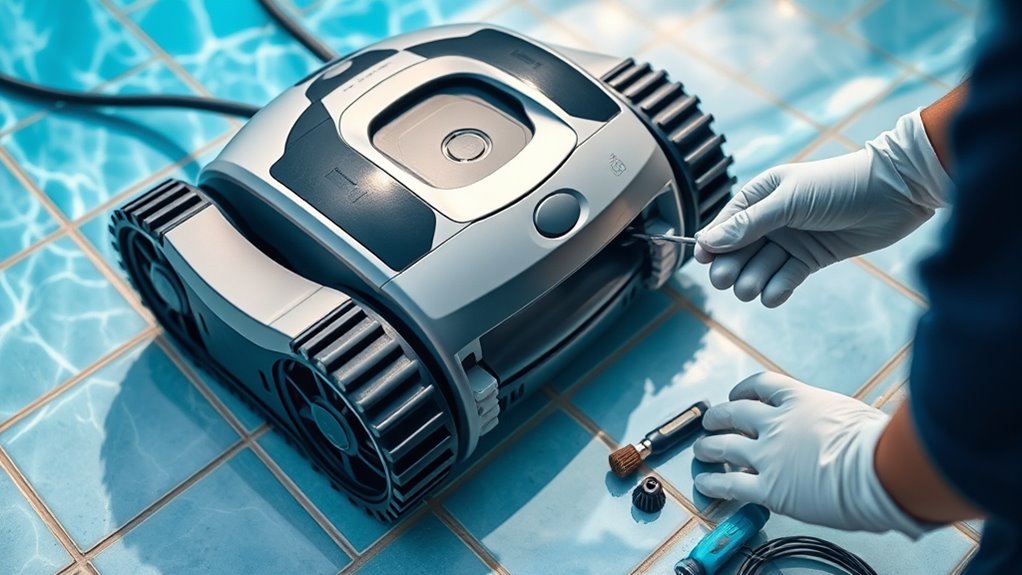
If your pool cleaner isn’t performing well, start by checking for obstructions that could block its movement. Next, examine the brush and filter for dirt or damage, and make sure they’re clean and functioning properly. Finally, inspect the drive motor to make certain it’s running smoothly without any signs of failure.
Check for Obstructions
Obstructions are a common cause of performance issues in your robotic pool cleaner. When it struggles to move or clean effectively, check for blockages that might be hindering its operation. To guarantee smooth functioning, perform obstruction removal and debris prevention regularly.
Look out for:
- Leaves or larger debris caught in wheels or brushes
- Twisted or tangled cords
- Blocked water intake vents
- Accumulated debris in the filter or intake area
Examine Brush and Filter
Have you noticed your robotic pool cleaner missing spots or moving sluggishly? It’s time to examine the brush and filter. First, check the robotic arm maintenance; debris or tangled brushes can hinder performance. Clean or replace worn brushes to restore effective scrubbing. Next, inspect the filter for clogs or dirt buildup, which can restrict water flow and reduce cleaning efficiency. Regularly cleaning the filter helps optimize battery life, ensuring your cleaner runs longer between charges. Also, verify that the brushes spin freely and are properly aligned. Neglecting these steps can cause the robot to work harder, draining the battery faster. By keeping the brush and filter in top shape, you improve overall performance and extend your cleaner’s lifespan.
Inspect Drive Motor
A common reason your robotic pool cleaner may struggle to perform efficiently is a malfunctioning drive motor. To troubleshoot, start with drive motor diagnostics to identify if the motor is the issue. Listen for unusual noises or if the cleaner isn’t moving properly. Check for debris or obstructions around the motor area. If diagnostics point to a faulty drive motor, you may need to follow motor replacement procedures. These include disconnecting power, removing the motor housing, and installing a new motor carefully. Keep in mind, proper inspection can prevent further damage. Consider consulting your user manual or professional service if you’re unsure about the process. Regular inspection ensures your cleaner runs smoothly and extends its lifespan.
Storing Your Robotic Cleaner Properly During Off-Season Periods
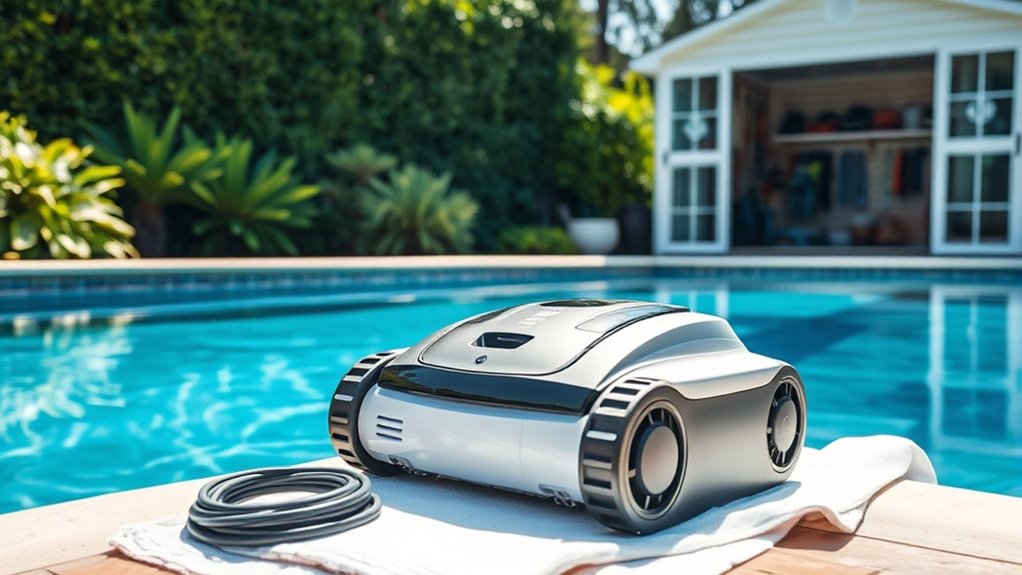
To guarantee your robotic pool cleaner remains in top condition during the off-season, proper storage is essential. Start by fully charging the battery before storing it to preserve battery life. Avoid leaving the cleaner in direct sunlight or extreme temperatures, as harsh storage conditions can damage internal components. Clean the device thoroughly, removing debris and rinsing off any dirt or chemicals. Once clean, dry it completely to prevent mold or corrosion. Store the cleaner in a cool, dry place, ideally in a protective bag or container to prevent dust buildup. Keep the power off and unplugged during storage. Properly stored, your robotic cleaner will be ready for excellent performance when next season begins.
Frequently Asked Questions
How Often Should I Service My Robotic Pool Cleaner Annually?
You should perform routine maintenance on your robotic pool cleaner at least once every three to four months, depending on usage and pool conditions. Stick to a cleaning schedule that includes cleaning filters and brushes regularly to keep it functioning effectively. Regular maintenance prevents breakdowns, extends the cleaner’s lifespan, and ensures your pool stays spotless. Adjust your schedule if you notice reduced performance or increased debris, ensuring consistent cleaning results.
What Are the Signs of Internal Motor Failure?
You’ll notice internal motor failure if your robotic pool cleaner starts making unusual motor noise or if you see reduced suction during cleaning. These signs indicate the motor isn’t functioning properly, which can lead to poor cleaning performance. If you observe these issues, it’s time to inspect the motor or seek professional servicing. Addressing motor problems early helps prevent further damage and keeps your cleaner operating efficiently.
Can I Upgrade Parts of My Robotic Cleaner Myself?
You can definitely handle DIY repairs and part upgrades on your robotic pool cleaner if you’re comfortable with basic tools. Start by consulting the manufacturer’s instructions and verify you have the right replacement parts. Carefully follow step-by-step guides or videos for installing upgrades or fixing components. Just remember, if you’re unsure or the repair is complex, it’s safer to seek professional help to avoid causing damage.
Is It Safe to Use My Robotic Cleaner After a Power Surge?
After a power surge, you should prioritize electrical safety before using your robotic pool cleaner. First, unplug the device and inspect for any visible damage or burn marks. Check your surge protection devices to verify they function correctly. If you’re unsure, it’s best to consult a professional or test the cleaner with a multimeter. Never operate your cleaner if you suspect electrical damage, as it could pose safety risks or damage the device further.
How Do I Troubleshoot Connectivity Issues With the Device?
Think of your robotic pool cleaner’s Wi-Fi as a delicate dance partner, easily thrown off by interference. If your device struggles to connect, check for Wi-Fi interference from other electronics and make certain your signal isn’t weak. Use signal boosters if needed to strengthen the connection. Keep the router close to the cleaner’s area, and reset both devices to clear any stubborn glitches. This will help your cleaner stay in step and work flawlessly.
Conclusion
Keeping your robotic pool cleaner in top shape guarantees it works efficiently whenever you need it. Regular inspections, timely replacements, and proper storage can extend its lifespan and save you money. Don’t wait until it’s too late—have you considered how much easier pool maintenance becomes when your cleaner is running smoothly? A little routine care now means fewer surprises later, so why not give your cleaner the attention it deserves?
